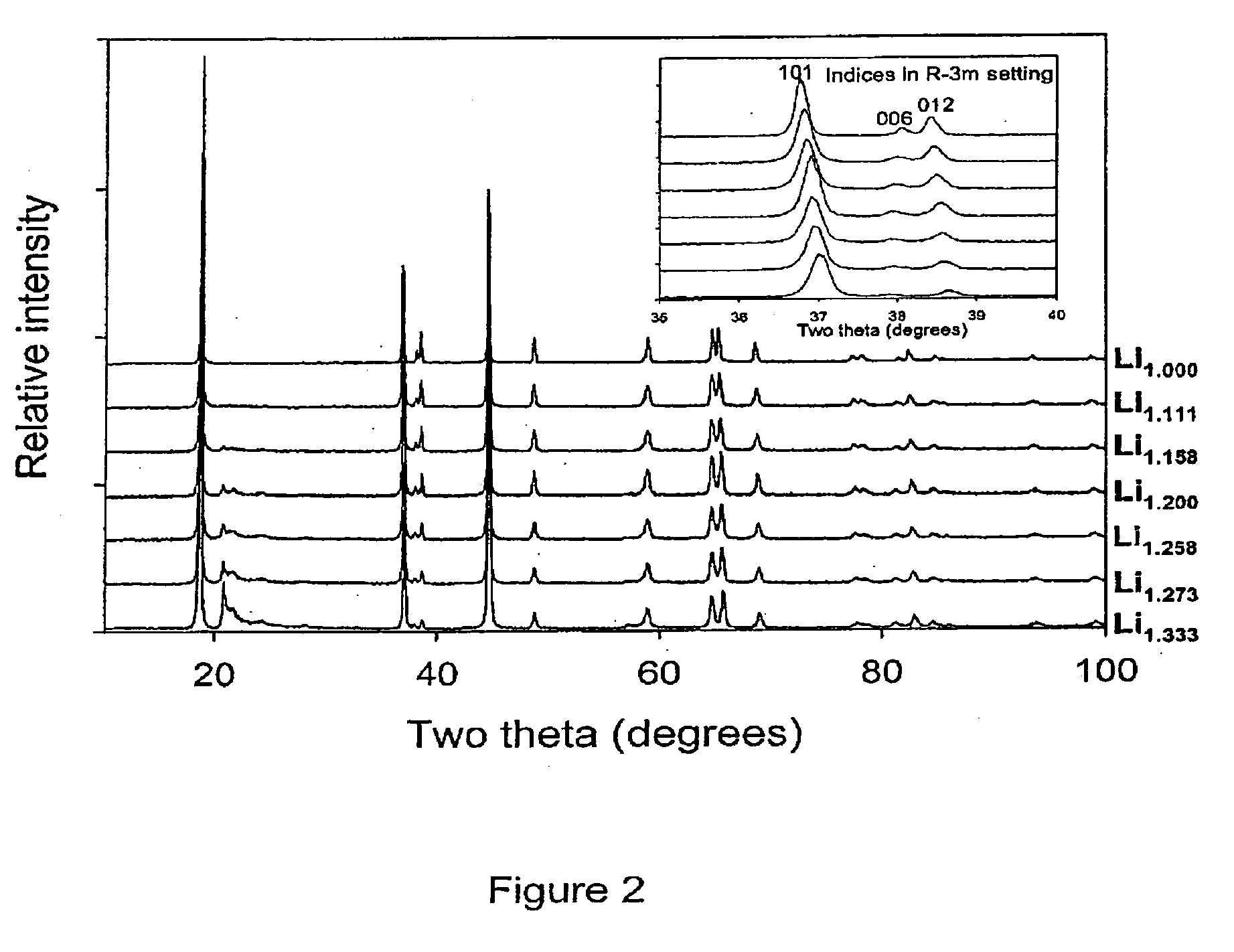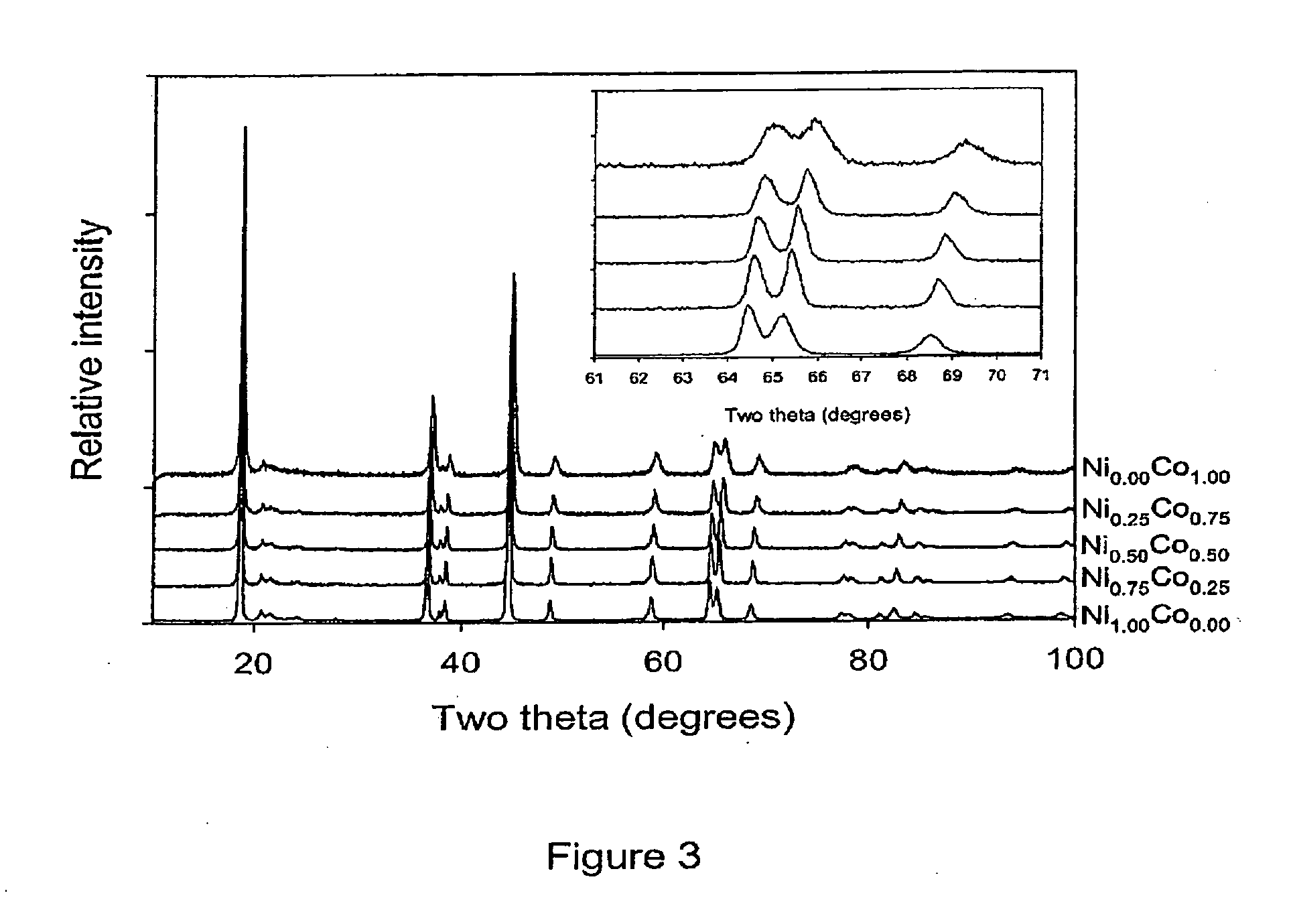Lithium metal oxide compositions
a technology of metal oxide compositions and compositions, applied in the direction of oxide conductors, metal/alloy conductors, conductive materials, etc., can solve the problems of reducing the electrochemical performance of cathode materials. , to achieve the effect of large reversible capacity, unique and much improved electrochemical behaviour
- Summary
- Abstract
- Description
- Claims
- Application Information
AI Technical Summary
Benefits of technology
Problems solved by technology
Method used
Image
Examples
example 1
[0060]This example describes the typical synthesis route of materials in the (1−x)Li2MnO3: xLiNi1-yCoyO2 (0≦x≦1; 0≦y≦1) solid solution series, wherein the general formula Lii+y / 3Mn2y / 3M(1−y)O2, M is Ni / Co. Mn(NO3)2.4H2O, Ni(NO3)2.6H2O, Co(NO3)2.H2O and LiNO3 were dissolved fully in water in the required molar ratios. Sucrose was added in an amount corresponding to greater than 50% molar quantity with regard to the total molar cation content. The pH of the solution was adjusted to pH 1 with concentrated nitric acid. The solution was heated to evaporate the water. Once the water had mostly evaporated the resulting viscous liquid was further heated. At this stage the liquid foamed and began to char. Once charring was complete the solid carbonaceous matrix spontaneously combusted. The resulting ash was calcined in air at 800° C., 740° C. or 900° C. for 6 hours. FIG. 1 shows the ternary phase diagram describing the (1−x) Li2MnO3: x LiNi1−yCoyO2 solid solution series, with the materials s...
example 2
[0078]Electrodes were fabricated from materials prepared as in example 1 by mixing approximately 78 wt % of the oxide material, 7 wt % graphite, 7 wt % Super S, and 8 wt % poly(vinylidene fluoride) as a slurry in 1-methyl-2-pyrrolidene (NMP). The slurry was then cast onto aluminum foil. After drying at 85° C., and pressing, circular electrodes were punched. The electrodes were assembled into electrochemical cells in an argon-filled glove box using 2325 coin cell hardware. Lithium foil was used as the anode, porous polypropylene as the separator, and 1M LiPF6 in 1:1 dimethyl carbonate (DMC) and ethylene carbonate (EC) electrolyte solution. A total of 70 μl of electrolyte was used to saturate the separator. The cells were cycled at constant current of 10 mA / g of active material between 2.0 and 4.6V at room temperature. The capacities observed on the first and thirtieth cycles are given in table 1.
[0079]FIG. 4 shows the electrochemical behavior of the first 3 cycles of materials in the...
example 3
[0083]Many lithium battery cathode materials do not perform well at elevated temperatures, their discharge capacities on extended cycling fading rapidly.
[0084]The electrochemical behavior of the materials of the invention were evaluated at elevated temperature. Identical cells were used to those at room temperature. FIG. 8 shows the discharge capacity of 800° C.-calcined Li1.2Mn0.4Ni0.3Co0.1O2 at 55° C. The voltage limits after the first cycle were reduced to avoid electrolyte decomposition. The material exhibited very stable capacities with very high reversibility in cycle 2 onwards. The average discharge voltage also remained quite stable for 55° C. cycling.
PUM
 Login to View More
Login to View More Abstract
Description
Claims
Application Information
 Login to View More
Login to View More - R&D
- Intellectual Property
- Life Sciences
- Materials
- Tech Scout
- Unparalleled Data Quality
- Higher Quality Content
- 60% Fewer Hallucinations
Browse by: Latest US Patents, China's latest patents, Technical Efficacy Thesaurus, Application Domain, Technology Topic, Popular Technical Reports.
© 2025 PatSnap. All rights reserved.Legal|Privacy policy|Modern Slavery Act Transparency Statement|Sitemap|About US| Contact US: help@patsnap.com



